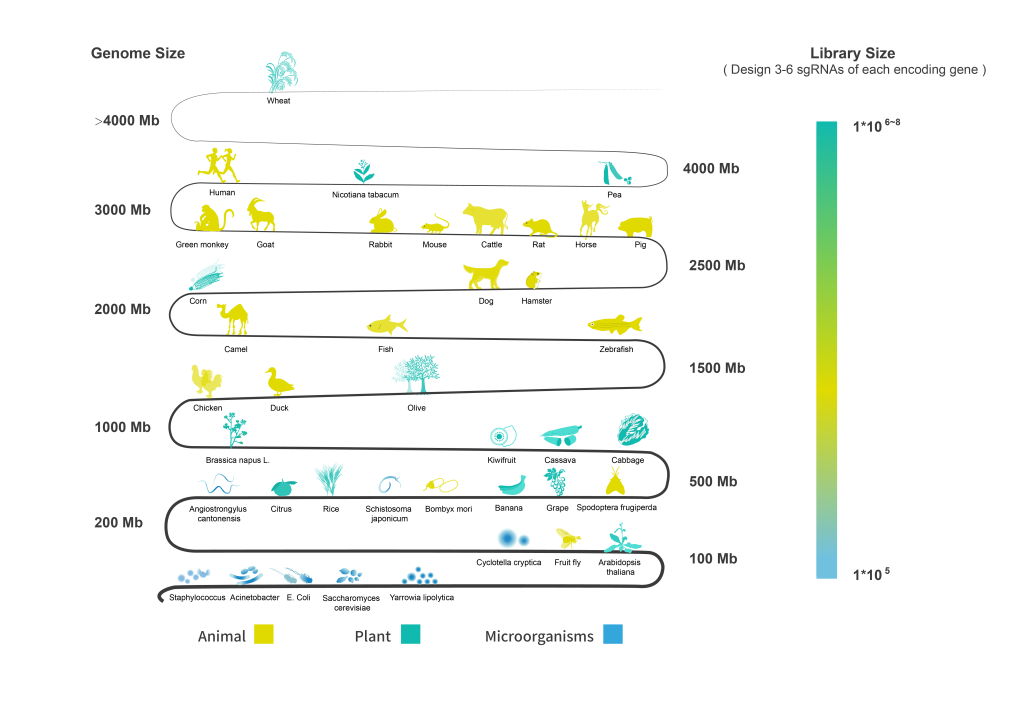General Introduction of sgRNA Customized Design
Single-guide RNA (sgRNA) is a key component in RNA-guided genome editing systems. It is a short, synthetic RNA sequence that directs a nuclease to a specific DNA target for cleavage or modification. sgRNA can be designed for different applications, such as gene knockout, base editing, and epigenetic regulation.
The sgRNA consists of two key regions:
-
Guide sequence (20 nucleotides) – Binds to the complementary DNA target via base pairing.
-
Scaffold sequence – Interacts with the nuclease protein, ensuring proper complex formation and function.
Synbio Technologies provides custom sgRNA design , genome-wide sgRNA library development, downstream verification, and stable cell line construction services. We offer a one-stop solution for genome editing projects to achieve high efficiency and reliability.

Highlights
-
![]()
- Well-designed Sequences
-
![]()
- More Than 20 Designed Species
-
![]()
- Customized sgRNAs
-
![]()
- Single sgRNA, Multiple sgRNA and sgRNA Library Design Services
Service Details
|
Service Program
|
Service Details
|
TAT
|
|
sgRNA design
|
The gRNA sequences are designed for specific gene classifications, with 3-6 sgRNAs designed for each gene
|
1-2 weeks
|
The Difference Between gRNA and sgRNA View More
The main difference between gRNA (guide RNA) and sgRNA (single-guide RNA) lies in their structure and application in RNA-guided genome editing systems:
-
gRNA (guide RNA) – This is a general term that refers to the RNA molecule responsible for directing a nuclease protein to a specific DNA target. In naturally occurring systems found in bacteria and archaea, the gRNA is composed of two separate RNA molecules: the crRNA and the tracrRNA.
-
sgRNA (single-guide RNA) – This is a synthetic, engineered version of gRNA commonly used in laboratory genome editing. It combines the crRNA and tracrRNA into a single RNA molecule, simplifying the system and improving efficiency for research applications.
FAQs
A unique primer binding site can be inserted into the screening library plasmid.
1. The GC content must be between 40% and 80% to ensure stable binding between the sgRNA and the target DNA.
2. Removal of polyA sites, which disrupt viral packaging if viruses are used for delivery.
3. Ensure that sgRNA designs have fewer secondary structures, such as hairpin structures and polymerase termination sequences; these structures can affect cloning efficiency and guide transcription.
How to Design Your sgRNA for RNA-Guided Genome Editing?
In gene-editing experiments, sgRNA is preferred because it is easier to design, synthesize, and use for targeted modifications. Designing an effective single-guide RNA (sgRNA) is crucial for achieving high specificity and efficiency in genome editing. Here’s a step-by-step guide to designing sgRNA:
1. Select Target Gene and Region
Identify the gene or sequence you want to edit. Choose a target site near the region of interest while considering the availability of a specific sequence motif (e.g., PAM-like motif).
2. Use an Online sgRNA Design Tool
Use bioinformatics tools like Benchling or CHOPCHOP to find high-efficiency sgRNA candidates while minimizing off-target effects.
3. Check sgRNA Design Criteria
A good sgRNA should be 20 nucleotides long, have 40-60% GC content, avoid homopolymeric sequences, and target the non-template strand if applicable.
4. Check for Off-Target Effects
Use online tools to scan the entire genome for unintended binding sites. Prioritize sgRNAs with fewer or no off-targets (especially in coding regions). Modify mismatches near the 5’ end if needed to reduce off-target binding.
5. Synthesize sgRNA or Genome Editing Vector Construction
Once selected, the sgRNA can be synthesized or cloned into a genome editing vector for expression.
6. Validate sgRNA Efficiency In Vitro
Perform a T7E1 assay or Surveyor assay to check cleavage efficiency. Use Sanger sequencing or NGS to confirm desired mutations. Optimize by testing multiple sgRNAs if needed.
Get in Touch with Us
Related Services
 DNA Synthesis
DNA Synthesis Vector Selection
Vector Selection Molecular Biology
Molecular Biology Oligo Synthesis
Oligo Synthesis RNA Synthesis
RNA Synthesis Variant Libraries
Variant Libraries Genome KO Library
Genome KO Library Oligo Pools
Oligo Pools Virus Packaging
Virus Packaging Gene Editing
Gene Editing Protein Expression
Protein Expression Antibody Services
Antibody Services Peptide Services
Peptide Services DNA Data Storage
DNA Data Storage Standard Oligo
Standard Oligo Standard Genome KO Libraries
Standard Genome KO Libraries Standard Genome Editing Plasmid
Standard Genome Editing Plasmid ProXpress
ProXpress Protein Products
Protein Products






























